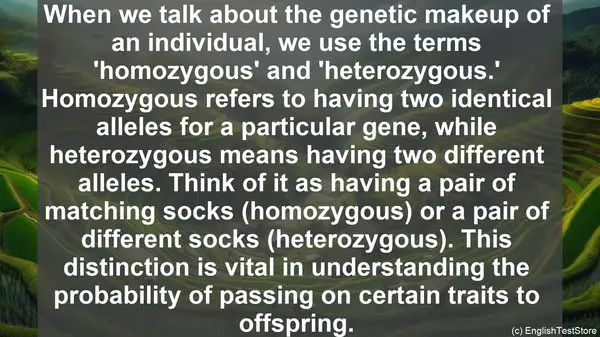Introduction
Welcome to today’s lesson on reproductive genetics. As you delve deeper into this field, you’ll come across several terms that may seem similar but have distinct meanings. In this lesson, we’ll explore the top 10 commonly confused words in reproductive genetics, ensuring you have a solid grasp on their differences. Let’s get started!
1. Gene vs. Allele
The terms ‘gene’ and ‘allele’ are often used interchangeably, but they refer to different aspects of genetic information. A gene is a segment of DNA that contains the instructions for a specific trait, while an allele is a variant of a gene. In simpler terms, a gene is like a recipe, and alleles are the different ingredients you can use to make that recipe. Understanding this distinction is crucial in comprehending how traits are inherited.

2. Homozygous vs. Heterozygous
When we talk about the genetic makeup of an individual, we use the terms ‘homozygous’ and ‘heterozygous.’ Homozygous refers to having two identical alleles for a particular gene, while heterozygous means having two different alleles. Think of it as having a pair of matching socks (homozygous) or a pair of different socks (heterozygous). This distinction is vital in understanding the probability of passing on certain traits to offspring.
3. Dominant vs. Recessive
Dominant and recessive are terms that describe the relationship between alleles. A dominant allele is one that, when present, will always be expressed in the phenotype, or the physical trait. On the other hand, a recessive allele is only expressed if both alleles in the pair are recessive. It’s like a game of rock-paper-scissors, where dominant always wins over recessive. This concept is central to understanding how certain genetic disorders are inherited.
4. Genotype vs. Phenotype
Genotype and phenotype are two fundamental concepts in genetics. Genotype refers to the genetic makeup of an individual, the combination of alleles they possess. Phenotype, on the other hand, refers to the observable traits, the physical manifestation of the genotype. A simple analogy is a computer program (genotype) and the output it produces (phenotype). Understanding this difference is crucial in studying the relationship between genes and traits.
5. Mutation vs. Polymorphism
In the context of genetics, a mutation and a polymorphism are two types of genetic variations. A mutation is a permanent change in the DNA sequence, often resulting in a new or altered trait. On the other hand, a polymorphism is a variation that is relatively common in the population and doesn’t usually cause any significant changes. It’s like a spelling mistake (mutation) versus a regional spelling variation (polymorphism). Distinguishing between the two is essential in understanding genetic diversity.
6. Carrier vs. Affected
When discussing genetic disorders, we often use the terms ‘carrier’ and ‘affected.’ A carrier is an individual who possesses a recessive allele for a particular disorder but doesn’t show any symptoms. On the other hand, an affected individual has the disorder and displays the associated traits. It’s like being a silent carrier (carrier) versus actively participating in a game (affected). This differentiation is crucial in understanding how certain disorders are passed on.
7. Prevalence vs. Incidence
Prevalence and incidence are terms used in epidemiology, the study of diseases in populations. Prevalence refers to the total number of cases of a disease in a population at a given time. Incidence, on the other hand, refers to the number of new cases that occur within a specific period. It’s like the number of people currently having a disease (prevalence) versus the number of new cases being diagnosed (incidence). Understanding these terms helps in assessing the impact of a disease.
8. Genetic Counseling vs. Genetic Testing
Genetic counseling and genetic testing are two important components of reproductive genetics. Genetic counseling involves providing information and support to individuals or couples regarding the risks and implications of certain genetic conditions. Genetic testing, on the other hand, involves analyzing DNA to identify specific genetic variations. It’s like getting advice from a professional (genetic counseling) versus conducting a diagnostic test (genetic testing). Both play crucial roles in reproductive healthcare.
9. Preimplantation Genetic Diagnosis (PGD) vs. Preimplantation Genetic Screening (PGS)
In the realm of assisted reproductive technology, two terms often come up: preimplantation genetic diagnosis (PGD) and preimplantation genetic screening (PGS). PGD involves testing embryos for specific genetic conditions before implantation, while PGS aims to identify chromosomal abnormalities. It’s like a targeted search (PGD) versus a broader scan (PGS). Understanding the differences between these techniques is vital in ensuring successful and healthy pregnancies.
10. In Vitro Fertilization (IVF) vs. Artificial Insemination (AI)
In vitro fertilization (IVF) and artificial insemination (AI) are two assisted reproductive techniques. IVF involves fertilizing an egg with sperm outside the body, while AI involves introducing sperm into the reproductive system. It’s like cooking a dish from scratch (IVF) versus using a pre-made sauce (AI). Knowing the distinctions between these methods is crucial for couples seeking reproductive assistance.

